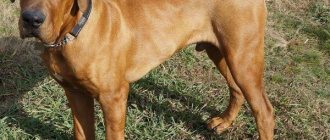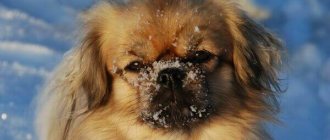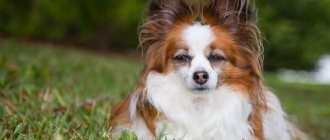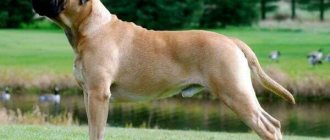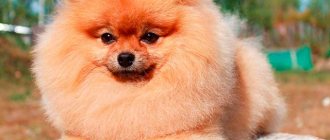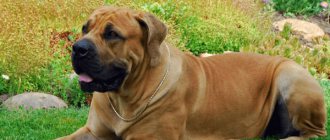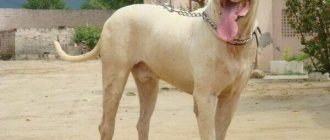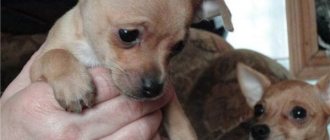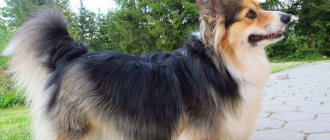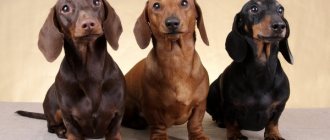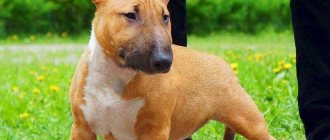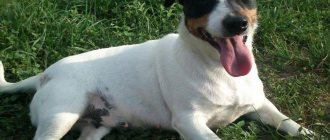Spaniels are a group of breeds that include a wide variety of dogs in purpose and size - from large hunting dogs to decorative dwarf dogs.
It includes Cocker Spaniels, English Springers, Sussexes, Field Spaniels, Irish Water Spaniels, German Wachtelhunds, Breton Espanolas and even Japanese Chins.
Japanese Chins or, as they were previously called because of the characteristic appearance of their ears, Japanese Spaniels, are a decorative breed of dogs.
The history of which is shrouded in mystery.
Today, due to their cute appearance and balanced character, these noble animals are one of the most popular companion dogs in the world.
Origin story and what it looks like in the photo
The Japanese Chin is one of the oldest breeds, the origin of which has not yet been precisely established..
One version says that its representatives were the sacred dogs of Buddha, another that the ancestors of these dogs are Tibetan Toys, according to the third version, Japanese Chins are the direct heirs of the Chinese Pekingese.
In ancient Japan, Chins were treated almost like royalty: they lived in large gilded cages and had personal servants.
Peasants were forbidden to keep these dogs; violation of the ban was severely punished; even the death penalty was not ruled out.
Japanese Chins could belong only to representatives of the upper classes, delight and amuse them, and also decorate the famous palaces of China, Japan and Korea.
The rulers of the Japanese Empire gave representatives of this breed to foreign ambassadors, thus showing them special respect. This is exactly what happened at the beginning of the 19th century. cinchines began to appear in Europe.
In the United States, they learned about these dogs only after Japan opened its borders in 1853.
After the First World War, the breed was on the verge of extinction; active work on its restoration began in the 50s of the 20th century. by members of American and English breed clubs. This selection led to the emergence of the modern type of Japanese Chin.
The breed was officially recognized by the International Canine Association in 1977, at which time the first standard was drawn up, and the dogs began to be called “Japanese Chin” and not “Japanese Spaniel”, as was previously the case..
Origin of the breed
The Chinese Chin dog breed was developed by people related to the imperial family. The Forbidden City of Beijing revered these animals, considering them sacred. Different families preferred to breed pets with a color, thickness of coat and size of the chin that was different from the neighboring palaces. Standards could even differentiate a dog's behavior. It was believed that it was impossible to look directly into the eyes of an animal, so as not to offend.
Only as a result of long-term selection can this type of dog be reproduced. Its miniature size and resistance to diseases, cheerful disposition and beautiful colors distinguish the chin from its similar relatives. The symmetrical coloring of the muzzle and ears, leaving a white stripe across the entire forehead, remains unchanged from generation to generation.
Over many centuries, the species has undergone changes in temperament and appearance, but veneration in its homeland has remained unchanged. There the dog is considered the animal of Buddha. The gradual spread of the Chinese Chin breed led to popularity in Japanese palaces. There was no ban on breeding outside the walls of temples. After the opening of the Japanese islands to the world, the favorites of the imperial families end up in Europe on ships.
Hin is an excellent watchman, able to distinguish friends from enemies. He loves to play; the dog’s peculiar character makes you think that it is trained. In fact, this is just a very intelligent and sensitive companion, capable of quickly accepting the rules of the game and behavior. Shows feelings in a peculiar way - touchy, but easy-going. Be sure to demonstrate his attitude towards others. Majestic behavior is reminiscent of descent from royal blood. The closest relatives of this dog are Pekingese, Japanese spaniels and Beijing palace dogs. It is believed that the Chinese Chin comes from the above mentioned breeds.
Miniature replicas of lions, sacred animals of Buddhists, are not considered dogs in their homeland. According to the inhabitants of the Land of the Rising Sun, only evil and sinful people could turn into dogs and deserve to be treated accordingly. Pekingese and chins are completely different creatures of unearthly origin and deserve special treatment. Possessing an affectionate disposition, they are focused on communicating with people and need family comfort.
Interesting Facts
- In Japanese, "hin" means jewel.
- It is believed that these dogs are able to protect the house from dark forces and evil spirits.
- There is a belief that Chins were fed rice and sake to prevent them from growing too large.
- Representatives of this breed were favorites of the British Queen Victoria, Nicholas II, US President Franklin Pierce, and Marshal Zhukov.
Natural qualities of the emperor's dog: a look from the past
Plunging into the historical past of the Japanese Chin, one can draw surprising conclusions. Neither in China, from where it was supposedly exported, nor in Japan itself, this breed was called a dog, which suggests a completely different attitude towards the pet.
It is known for certain that for Asians, the ancestors of modern Chins were sacred creatures, the personification of God on earth, his messengers, shrouded in an aura of magic. It goes without saying that these heavenly creatures simply could not have disadvantages, and the list of advantages could be listed endlessly.
Chins, who bore the stamp of the Buddha, were accessible only to the “high society”: kings and nobility, where they had the highest privileges. The purpose of these wonderful dogs was initially not hunting and protection, but only to create an atmosphere of comfort and a special aura in palaces and rich houses, conducive to harmony and the enjoyment of beauty. Such a life laid the foundation for the characteristics of the Japanese Chin breed, which had a lot of advantages and not a single disadvantage - after all, the “lion Buddha” or the “divine flower” from legends simply cannot have them.
The chronicles of past times attribute to the breed such characteristics as courage and courage, loyalty and the ability to sacrifice, divine beauty and self-esteem.
Centuries have passed, but the basis of the breed's characteristics has not changed at all. Changes have occurred only in the environment in which this “happiness-bringing messenger of the Buddha” now lives. Speaking about the pros and cons of the breed, it is worth noting that the negative characteristics of the Japanese Chin attributed by people are often the result of inept handling of the pet or a lack of understanding of the reasons for the dog’s behavior in everyday life.
Description and standard
Japanese Chins are miniature and graceful dogs with a harmonious physique and proud bearing..
The length of the body of representatives of this breed should be equal to the height at the withers, however, in bitches a slightly elongated format is possible, which is due to the need to bear offspring.
Breed standard:
- the skull is wide, rounded, the transition from the forehead to the short and upturned muzzle is sharp, the stop is deep and depressed;
- the bridge of the nose is short and wide, the nose is located in line with the eyes, pigmented black or to match the coat color spots;
- straight or scissor bite;
- the ears are long, hanging, V-shaped, set wide, abundantly covered with hair;
- the neck is moderately long, without dewlap, smoothly blending into the withers;
- the eyes are large, round, the iris is almost black;
- the back is straight, short, the lower back is rounded;
- The chest is wide, the ribs are arched;
- tucked stomach;
- the tail is set high and lies on the back;
- the forelimbs are straight, set parallel, the hind limbs with slight angles;
- The paws are small, oval, the toes are tightly clenched.
The coat is straight, silky, thick and long . There is practically no undercoat. The ears, tail, hips and collar have more fur than other parts of the body.
Reproduction
In their homeland, Chins are considered a special treasure and they never allow themselves to make money from breeding. Special nurseries are engaged in professional breeding of Imperial Chin offspring, giving the opportunity to acquire a little friend.
Mating Chin girls is often problematic. Since after it, such bitches have complicated childbirth, and it is impossible to do without medical intervention. Therefore, experts advise you to think many times before deciding to breed this breed of dog.
Character traits
Japanese Chins are smart and quick-witted dogs with a lively and easy-going disposition . Despite their energy, they are not characterized by fussiness - they are moderately active and have a balanced psyche.
Representatives of this breed love care and attention, but at the same time they are self-sufficient and unobtrusive - chins are amazingly able to guess the mood of their owners, they feel and understand when they need to wait a while instead of imposing their company.
Being miniature dogs and not created for any kind of work, Japanese Chins are distinguished by amazing fearlessness, bordering on recklessness - if the owners are in danger, the pet without hesitation comes to his defense and does not give in even to a much larger opponent.
Japanese Chins are accustomed to receiving admiring glances and love to be treated with awe and adoration..
At the same time, they do not tolerate a familiar attitude, and they treat strangers with suspicion and wariness, not allowing them to touch themselves.
When surrounded by a family, dogs behave differently - they are affectionate and friendly, they get along with everyone in the household, but they always choose one person to treat with special love..
Expert opinion
Kozhevin Semyon Kirillovich
Expert dog handler.
One of the main character advantages of Japanese Chins is their unobtrusiveness. Despite the need for the owner's care and thirst for his attention, the pet will never intrude or bother you, especially if it feels that the owner is upset or angry. These dogs have never been used for work and now it is impossible to make watchmen or security guards out of them, however, training is still necessary, as well as early socialization - without this, the puppy grows up to be a fearful and timid dog.
Precautions for keeping
You need to carefully watch your step so as not to step on and injure your miniature dog. Close interior doors carefully, controlling the location of the four-legged animal so as not to crush it. Electrical wires that can be chewed or bitten and receive an electric shock must be removed from places accessible to the pet. Small cracks between the furniture, it is better to close the passages so that the curious Chinese Chin (the photo of the puppy is presented above for clarity) does not get stuck when trying to crawl inside.
You need to go out for a walk with your dog in safe places where there is no possibility of other dogs running over or attacking a small animal. A harness or the thinnest leash will not work. Even the softest collar can ruin a lion’s fluffy mane and injure the delicate skin of a short neck.
Advantages and disadvantages
Representatives of this breed have a lot of advantages, among which most often stand out::
- affectionate and friendly disposition;
- courage;
- devotion;
- cleanliness;
- occasional barking;
- agreeableness;
- unobtrusive behavior and self-sufficiency;
- balanced psyche;
- mind;
- ability to get along with children and pets.
In addition, Japanese Chins do not require complex care, and their coat does not have an unpleasant, specific dog odor.
These dogs don't have many faults.:
- heavy shedding;
- difficulties in learning and training;
- touchiness;
- stubbornness;
- snoring in your sleep.
It should also be taken into account that the brachycephalic structure of the skull causes breathing problems, especially in winter.
How much does a Japanese chin cost?
A puppy can be purchased from ordinary owners for an amount from 4.5 to 10 thousand rubles. However, in this situation, purebred is not guaranteed. The baby may turn out to be a mixed race. Often, unscrupulous breeders breed this breed with the Pekingese.
For a class below average, nurseries usually set the price in the range of 10-12 thousand rubles. For a more common breed class, the price of a Japanese Chin will be from 15 to 17 thousand rubles. Representatives of the show class, who are more often chosen to participate in future exhibitions, cost at least 25-26 thousand rubles and more. The most thoroughbred, purebred and beautiful puppies are sold for 60 thousand rubles. The price range depends not only on the quality of the puppy, but also on the kennel/breeder itself.
Do you like the article? 0
Difference from Pekingese
It is believed that Japanese Chins and Pekingese had a common ancestor and these dogs were previously classified as the same breed, but there is no documentary evidence of this.
Be that as it may, representatives of these breeds are very similar both in appearance and in character and habits.
However, there are some differences between Chins and Pekingese.:
- the homeland of the Chins is Japan, the Pekingese are China;
- Pekingese weigh slightly more than quinines;
- cinchona, due to its long limbs, is significantly higher.
In addition, the coat of Japanese Chins is less fluffy, but smoother and flowing . What distinguishes these dogs from other similar breeds is their original coat color.
Description of the Japanese Chin breed
Popularity 104th place among 263 dog breeds
Lifespan:
10-12 years
Breed group:
Decorative
Height:
20-27 cm
Country of origin:
Japan, China
Average price:
5-15 thousand rubles
Weight:
2-5 kg
Latest articles Cat health
Ataxia in cats: what it is, how it manifests itself and is treated 01/23/2022 151 0 0
Cat health
Leukemia, or viral leukemia in cats 01/23/2022 140 0 0
Color variations
The official breed standard for Japanese Chins suggests only 2 coat colors: white-black and white-red.
White black
The most common color variant, in which there are black spots on the main white color of the coat . The lobe is pigmented black; the presence of pink spots on it is unacceptable.
White-red
The white coat has red spots, the shade and intensity of which can vary from light lemon to chocolate . The nose is pigmented to match the spots on the coat; there should be no pink spots on it.
CAREFULLY!
Individuals with dark chocolate spots should not be bred, as their puppies are often born sick and even dead.
With any color option, the spots should be symmetrically located around the eyes, covering the ears and body, on which they can be located randomly or balanced, which is more preferable.
In addition, it is desirable to have a white mark running from the bridge of the nose to the forehead, on which there may be a small black spot, which is called the Buddha finger.
Dossier
Adult dog height: 25-30 cm. Weight: 3 kg. Characteristic color: white with black or red spots. Coat length: longhaired. How long does a Japanese Chin live: up to 16 years. Advantages of the breed: charming, obedient, sensitive. Difficulties of the breed: the coat needs to be brushed every day, loves to spend time with the owner. How much does a Japanese Chin cost: $150-1600. Classification: small, decorative, companion.
Is he good with children and does he get along with other pets?
Chins get along well with children - these dogs are not characterized by aggressive behavior, especially towards children. At the same time, it is better to have such a pet for families with school-age children, since a younger child can inadvertently injure a miniature and fragile dog.
Due to their friendly disposition, lack of hunting instincts and tendency to dominate, representatives of this breed easily get along with other pets, including cats and rodents.
Tips for choosing a puppy
If you decide to get a puppy, choose a seller who is responsible and verified by reviews. The most correct thing would be to contact a breeding nursery with a good reputation and official confirmation of breeding of this particular breed. Professionals will help you choose a puppy, correctly draw up documents about its health status, a certificate of pedigree and characteristics of breeding qualities.
First visit the premises and make sure the puppies are well cared for, kept clean and appear healthy. Examine the baby you like from head to tail. The ears should be clean, the eyes clear, the teeth white, the gums pink, and the coat soft. Observe the movements of the chin. Any strange behavior or repetitive action may indicate a possible medical condition.
Find out about the health of the parents, especially the mother of the puppy during pregnancy. Any complications during gestation can lead to the development of pathologies in puppies, including hydrocephalus (impaired circulation of the fluid that washes the brain).
It is very important to take a closer look at how other Japanese Chin puppies from the same litter behave. If you are choosing an animal to participate in exhibitions, it is better to see both parents. This will allow you to understand how fertile the quin you have chosen is.
How to properly care
Japanese Chins require simple but regular grooming. The owner's main efforts should be aimed at caring for the coat, which sheds profusely and can become tangled.
Wool and bathing
The Chin's coat should be brushed daily with a massage brush; during shedding, a furminator should be used - this will help get rid of dead hairs and avoid the formation of tangles.
NOTE!
Representatives of this breed do not need to be cut; only trimming the fur between the toes is allowed.
These dogs should be bathed once every 3-4 months, using a mild shampoo appropriate for their coat type and conditioner..
More frequent washing is not required, since their coat does not retain dirt, and a small amount of it is easily removed during combing.
Ears
Inspect your ears weekly and, if necessary, clean them of wax and dust accumulation with a cotton pad soaked in a special lotion or hydrogen peroxide.
Claws
The nails of representatives of this breed grow quickly and tend to bend and split, which prevents the dog from walking..
If they do not wear down on their own during walks, they should be shortened with a guillotine nail cutter every 7-10 days, but for some individuals monthly trimming is enough.
Teeth
Brush your teeth several times a week with a special brush and toothpaste for dogs - this prevents the formation of plaque and tartar.
Eyes
Cinchonas are prone to increased lacrimation, which often causes the eyes to become sour . Therefore, they should be wiped daily with a lint-free cloth or cotton pad soaked in tea leaves and furatsilin solution.
Care and maintenance
Keeping and caring for the Japanese Chin is quite simple. The dogs are very clean and independent. It is advisable to walk 2-3 times a day. If you do not have such an opportunity, it is easy to accustom your Chin to a home tray or diaper. Then you can limit yourself to one walk for 20 minutes or more. For walking, it is preferable to choose a harness instead of a collar, since the animal has a very delicate neck.
When letting your dog off the leash, watch him closely. He easily jumps onto high slides, curbs, stairs or fences and may unexpectedly fall from them. Your pet's bones and joints are fragile, and after such falls from heights there is a possibility of a fracture or dislocation.
The Chin's coat is quite easy to care for. About 1-2 times a week, it is advisable to comb it out of fluff, removing tangles and accumulated dust. As the fur grows, you need to carry out a superficial haircut, cutting off excess and interfering pieces.
Bathing is carried out no more than once every two weeks using antimicrobial, antiparasitic shampoos and conditioners, which are sold at any pet store or veterinary pharmacy. This way the wool will not fluff and curl. After water treatments, the dog needs to be thoroughly dried. A simple dry towel or hairdryer will do for this if your pet is not afraid of loud noises.
Instead of bathing, you can clean your furry friend with dry shampoo in the form of a special powder. Ordinary talcum powder or baby powder will also work. Gently rub the product into the fur, spreading it over the entire body, and comb thoroughly.
Ears should be washed and wiped as needed. It happens that the furry friend himself hints about this, constantly scratching his ears and shaking his head. After each walk, it is recommended to wipe the paws with a clean cloth or simply wash away the dirt between the pads.
The claws grow quickly and often split. You can help your dog with regular haircuts using one of the following devices: a nail clipper, a guillotine trimmer, sharp scissors and a hard file. The fluffy will be very grateful to you for such a “pedicure”, since long and sharp claws greatly interfere with his active play, running, washing and moving.
The main condition for a pet’s healthy life is a timely examination by a veterinarian. This is especially important for older animals!
Life expectancy, health and major diseases
On average, Japanese Chins live 10-14 years, but they cannot be called the owners of good health.
Representatives of this breed are prone to many diseases typical of toy dogs and animals with brachycephalic skulls:
- dropsy of the brain;
- GM2 gangliosidosis;
- distichiasis;
- cataract;
- progressive retinal atrophy;
- entropion of the eyelid;
- misalignment of the jaw, multiple teeth, false polyodontia;
- digestive system dysfunction;
- underdevelopment of the reproductive system;
- dislocations of the elbow and kneecaps;
- necrosis of the femoral head;
- laryngeal paralysis;
- glaucoma;
- chronic rhinitis;
- allergy;
- conjunctivitis;
- dislocation of the eyeball;
- tracheal collapse;
- nostril stenosis.
Most diseases can be avoided by providing your pet with proper care and regular visits to your veterinarian for routine checkups..
Puppy age
There is no clear answer to the question at what age you can take a Japanese Chin into your home. The main condition is that the puppy must defecate on its own, be able to eat solid food, and receive the skill of primary socialization from its mother and fellow breeders.
You can also adopt a grown-up puppy, aged six months or older, and receive additional bonuses:
· The kids have already been vaccinated, and you can immediately start walking outside with them.
· They are trained to go to the toilet and know what a litter box is.
· Puppies adapt faster to a new environment and do not miss their mother so much.
· The older the puppy, the better you can see what kind of character and appearance he has.
The optimal age for a puppy to be picked up from the breeder is 3 months.
Nutritional Features
For healthy growth and development, Japanese Chins require a balanced diet based on protein and also containing carbohydrates, fats, vitamins and minerals.
The type of feeding depends on the preferences of the owner and his ideas about what is healthier for the pet - it can be industrial food or natural products.
Ready-made food is more convenient to use and dose; it does not require time to prepare food for the dog and contains all the necessary macro- and microelements.
At the same time, in the event of an allergy to one of the components of the food, a complete replacement of the diet will be required, and the use of products made from low-quality raw materials and containing chemical additives will negatively affect the health of the pet.
IMPORTANT!
The most popular foods: Acana, Orijen, Artemis, Canidae, Almo Nature, Arden Grange, 1st Choice, Happy Dog, Royal Canin, Brit Premium.
When feeding a dog on a natural diet, you should include:
- lean meat - turkey, chicken, beef, veal;
- beef by-products – kidneys, heart, liver, lung, tripe;
- sea and ocean fish;
- porridge – rice, buckwheat, oatmeal;
- boiled yolk;
- vegetables and fruits;
- fermented milk products - cottage cheese, kefir, natural yogurt.
It is forbidden to feed chins:
- legumes;
- fatty meat;
- potatoes;
- river fish;
- citrus fruits;
- fatty and fried foods;
- sweets;
- smoked meats and sausages.
It is enough to feed adult individuals 2 times a day, dividing the recommended 125 g of food into several feedings.
Ainu Dog or Hokkaido Dog
Hokkaido, or Ainu, Ainu-ken, Seta, Shita, also participated in the Second World War, but on the side of the Japanese. Used to transmit information and search for enemy camps. Like Shikoku, it was declared a Japanese natural monument in 1937. The ancestors of Ainu were dogs that participated with the Ainu tribes in hunting bears and other large animals.
Hokkaido have retained all their hunting animal instincts, which causes them to have a rather cruel disposition with a very cute appearance. Ainu does not tolerate other animals and strangers, and in addition, he constantly fights for power with anyone who claims it. Therefore, keeping such animals in a city apartment or large family is not recommended.
Other breeds worth mentioning include the Japanese Spitz, Japanese Terrier, Ryukyu, Jomon Shiba, Shiba Inu and Tosa Inu. But we can talk about them next time.
How to train correctly?
Japanese Chins are smart, they quickly remember commands, and if desired and with due diligence, they can be taught various funny tricks.
Training is best done in a playful way, without forcing the dog to repeat the same command over and over again - 5-6 times is enough..
You should not scold or hit your pet, you should also not roughly touch its face or tail or make sudden movements - this can lead to disorientation of the dog and provoke aggressive behavior.
Japanese Chins are rarely food eaters; they respond better to encouragement in the form of praise.
Despite their miniature size, representatives of this breed must be taught the basic commands “Fu”, “Come to me”, “Place”, “Nearby” - they help control the pet during walks and provide more guarantees of its safety.
The commands “Sit”, “Lie down”, “Give me a paw” will not be superfluous - even if the dog does not participate in exhibitions, a set of these commands will help make caring for it easier at home.
Training should begin at about 3 months, first at home, where the puppy is not distracted by anything and the whole environment is familiar, later you can train him on the street during walks.
Training and education
The Japanese Chin is distinguished by great intelligence, but at the same time it has a wayward character. He will not obey a command for tasty food; the main reward for him is love and affection. The animal does not tolerate rudeness and violence; even raising your voice can dramatically worsen the relationship between the dog and the owner.
Chins easily learn the basics, but this must be done in stages. Reinforce the command by repeating it, but do this no more than 7 times, otherwise the pet will get tired and lose interest. When an animal is capricious, there is no need to insist on continuing training. In the life of a pet, it is important to carry out early socialization: take it for walks, where there are a lot of people and animals, so that the chin gets used to them. Otherwise, the dog may grow up tense and timid.
How to choose? Boy or girl?
It is better to purchase a puppy not from hand, but from a specialized nursery, where breeders guarantee its health and purebred.
Before purchasing, you should inspect the premises where the dogs are kept, observe their behavior, meet the parents of the future pet and ask the breeder about their health.
The puppy you like the most should be carefully examined: it should have clean ears without redness, clear, mischievous eyes, pink gums, white teeth without signs of underbite or overbite, soft and shiny coat.
The baby should be active, cheerful, and have a good appetite.
"Cow" hind legs, instability, too low sternum, conjunctivitis, rhinitis, lameness and other symptoms of pathologies or abnormal development are unacceptable.
Sakhalin Husky
The Sakhalin Husky, called the Karafuto-Ken by the Japanese, is considered an endangered breed that survives today in small numbers only in Japan. It was once bred in Russia to transport goods, so the dog is strong, large and very independent. She has a calm character, good health and great stamina.
Although the husky first appeared in Russia, where it was called the Sakhalin Laika, the breed is currently under the patronage of Japan. Gone are the days when local tribes used it to bait bears, and today the Husky is a beautiful and balanced animal, very loyal to its owner. During the Second World War, these huskies were considered the best for military service on the eastern outskirts of the country.
Nurseries in Russia and CIS
- "Evelveys", Russia, St. Petersburg;
- “Medangen”, Russia, Ekaterinburg;
- PradoRocks, Russia, Bryansk;
- “Legend of Kings”, Russia, Tula;
- “Hin Matsuri”, Belarus, Gomel;
- “Sunny Country”, Belarus, Vitebsk;
- Fluffy Pet, Ukraine, Dnepropetrovsk;
- Rodnichok iz Tiger Sada, Ukraine, Poltava;
- “Playful Ray”, Ukraine, Nikopol.
